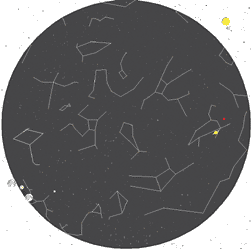Sky Watch by J. Alex Knoll
The Yin of Summer Solstice
There’s ancient science behind that symbol of balance
The waning gibbous moon rises late in the evening at week’s end, flanking Jupiter Thursday and Friday night.
At 7:59pm Friday, the sun reaches its northern apex, marking the beginning of summer in the Northern Hemisphere and the longest day of the year at 14 hours 54 minutes and 19 seconds. Like a roller coaster nearing the peak of a long drop, the sun’s movements slow as it nears its apex. In the couple days surrounding summer solstice, the sun appears to rest at the same point overhead at noontime, hence the word solstice’s Latin roots: sol, meaning sun, and sistere, to cause to stand still.
Northern cultures have long celebrated summer solstice. The Celts of England and Western Europe marked the occasion as Midsummer Night and celebrated with bonfires from dusk thru dawn. Revelers jumping through the flames were believed to share in the sun’s strength, and newlyweds who did so strengthened their union.
The ancient Chinese celebrated the feminine forces of the earth — yin — on summer solstice with feasts marking the bounty of the season. In contrast, winter solstice marked the peak of the masculine forces of the heavens — yang. In fact, the yin-yang symbol was created millennia ago by Chinese astronomers marking shadows cast on an eight-foot rod during the course the year and dividing the sun’s cycles into concentric circles and points.
Tidelog®
Illustration: © Copyright 1925 M.C. Escher/Cordon Art-Baarn-Holland; Graphics: © Copyright 2007 Pacific Publishers. Reprinted by permission from the Tidelog graphic almanac. Bound copies of the annual Tidelog for Chesapeake Bay are $14.95 ppd. from Pacific Publishers, Box 480, Bolinas, CA 94924. Phone 415-868-2909. Weather affects tides. This information is believed to be reliable but no guarantee of accuracy is made by Bay Weekly or Pacific Publishers. The actual layout of Tidelog differs from that used in Bay Weekly. Tidelog graphics are repositioned to reflect Bay Weekly’s distribution cycle.Tides are based on National Oceanic and Atmospheric Administration and are positioned to coincide with high and low tides of Tidelog.
